ESP JAGUAR XJ6 1994 2.G Electrical Diagnostic Manual
[x] Cancel search | Manufacturer: JAGUAR, Model Year: 1994, Model line: XJ6, Model: JAGUAR XJ6 1994 2.GPages: 327, PDF Size: 13.73 MB
Page 94 of 327
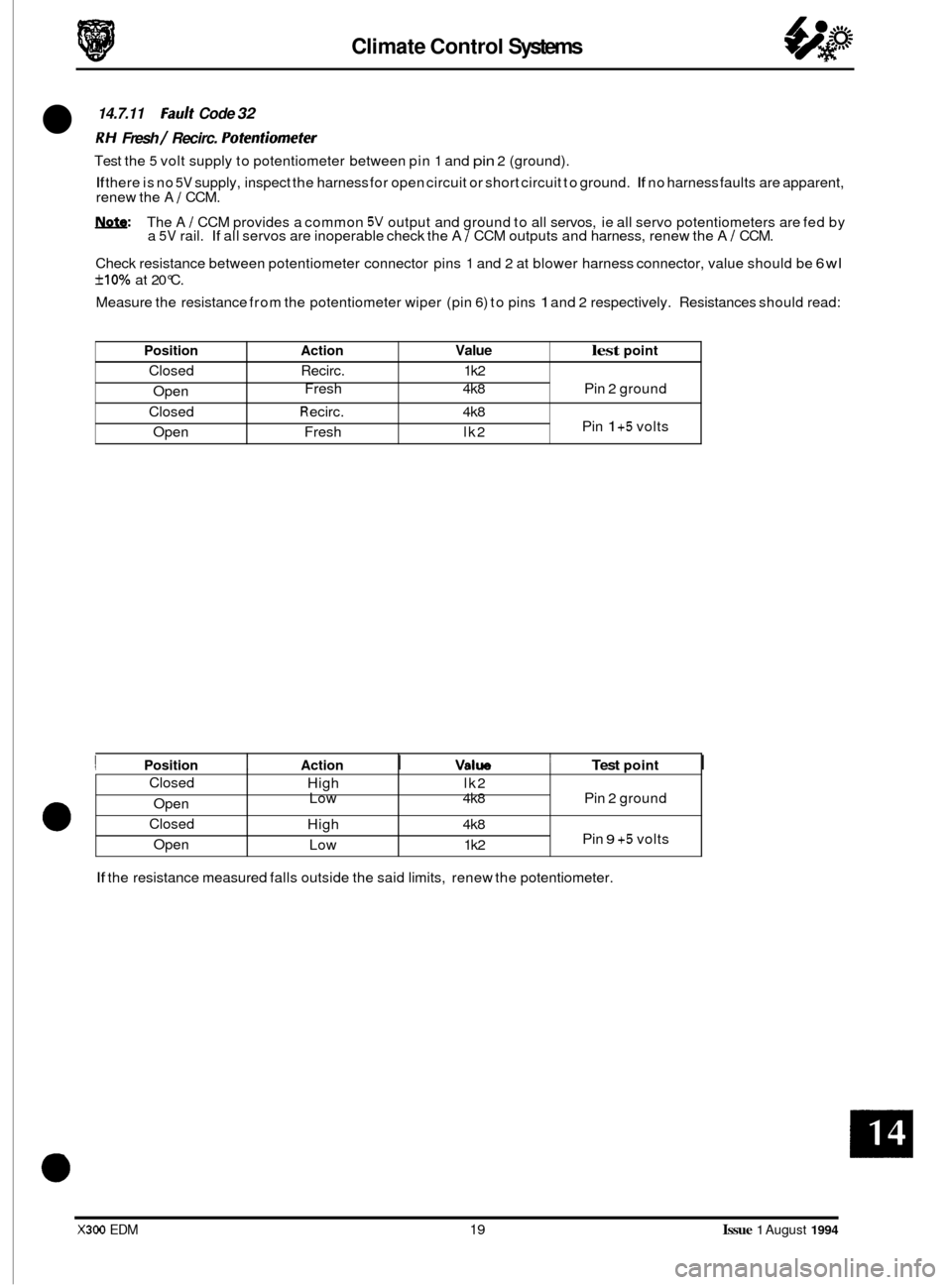
Climate Control Systems
Position
Closed Open
Closed Open
14.7.11 Fault Code 32
RH Fresh / Recirc. Pofenfiomefer
Test the 5 volt supply to potentiometer between pin 1 and pin 2 (ground).
If there is no 5V supply, inspect the harness for open circuit or short circuit to ground. If no harness faults are apparent,
renew the A 1 CCM.
W: The A / CCM provides a common 5V output and ground to all servos, ie all servo potentiometers are fed by
a 5V rail. If all servos are inoperable check the A 1 CCM outputs and harness, renew the A I CCM.
Check resistance between potentiometer connector pins 1 and 2 at blower harness connector, value should be
6wl
f10% at 20°C.
Measure the resistance from the potentiometer wiper (pin
6) to pins 1 and 2 respectively. Resistances should read:
Action Value lest point
Recirc. 1 k2
Fresh 4k8 Pin 2 ground
R eci rc. 4k8
Pin 1 +5 volts
Fresh lk2
Closed Open
Closed
Open
e
I Position I Action I Valw 1 Test point I
High lk2
Low 4k8 Pin 2 ground
High 4k8
Pin
9 +5 volts
Low 1 k2
If the resistance measured falls outside the said limits, renew the potentiometer.
X300 EDM 19 Issue 1 August 1994
Page 95 of 327
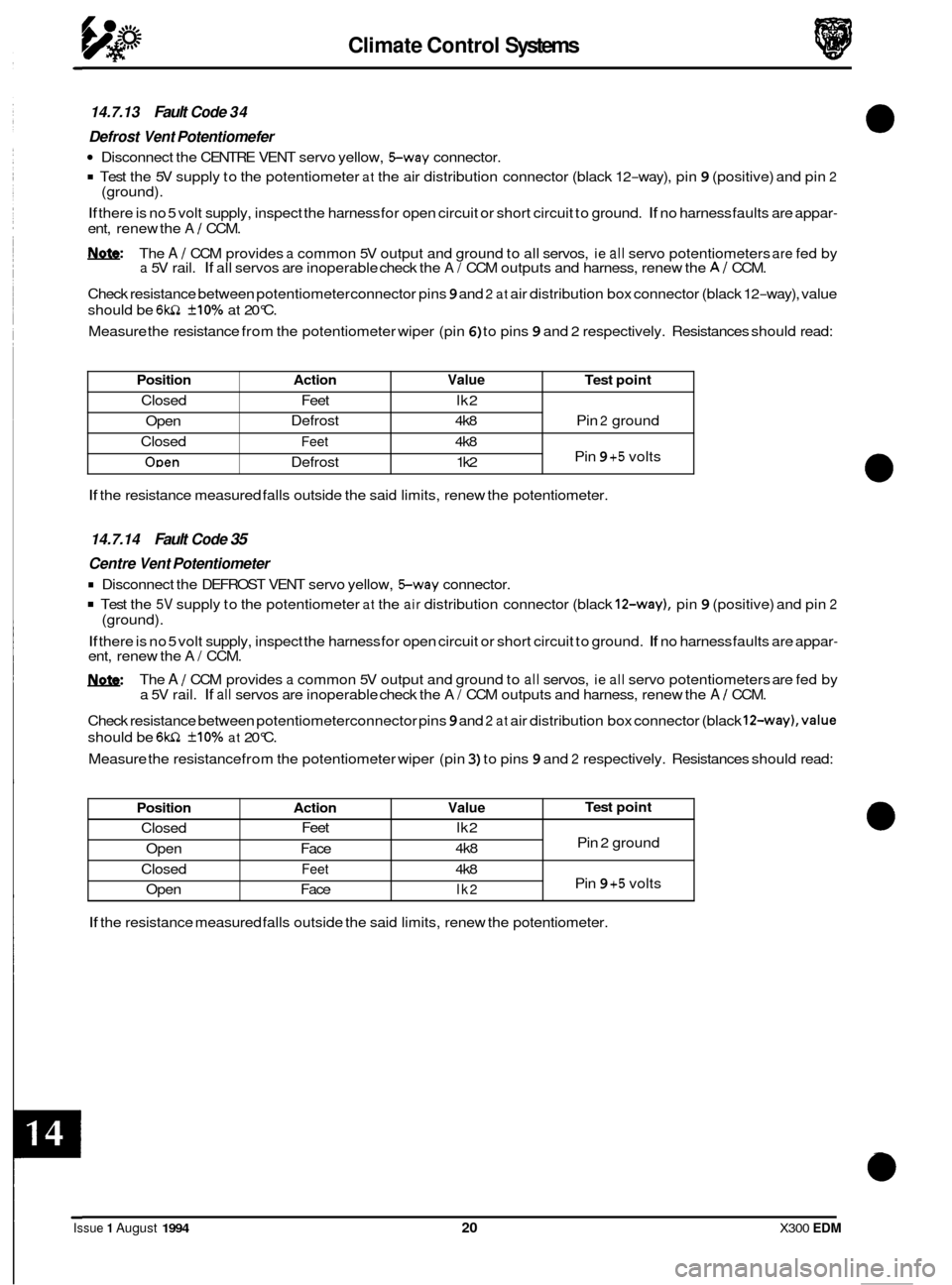
Climate Control Systems
Position
Closed
Open
Closed
ODen
14.7.13 Fault Code 34
Defrost
Vent Potentiomefer
Disconnect the CENTRE VENT servo yellow, Sway connector.
Test the 5V supply to the potentiometer at the air distribution connector (black 12-way), pin 9 (positive) and pin 2
If there is no 5 volt supply, inspect the harness for open circuit or short circuit to ground. If no harness faults are appar-
ent, renew the A / CCM.
&&: The A / CCM provides a common 5V output and ground to all servos, ie all servo potentiometers are fed by a 5V rail. If all servos are inoperable check the A/ CCM outputs and harness, renew the AI CCM.
Check resistance between potentiometer connector pins
9 and 2 at air distribution box connector (black 12-way), value
should be
6w1 +10% at 20°C.
Measure the resistance from the potentiometer wiper (pin
6) to pins 9 and 2 respectively. Resistances should read:
(ground).
Action Value Test
point
Defrost 4k8 Pin 2 ground
Feet 4k8
Pin 9 +5 volts
Defrost 1 k2
Feet
lk2
Position Action Value
Closed Feet
lk2
4k8
Open Face
Closed
Feet 4k8
Open Face
lk2
If the resistance measured falls outside the said limits, renew the potentiometer.
Test point
Pin 2 ground
Pin
9 +5 volts
14.7.14 Fault Code 35
Centre Vent Potentiometer
Disconnect the DEFROST VENT servo yellow, Sway connector.
Test the 5V supply to the potentiometer at the air distribution connector (black 12-way), pin 9 (positive) and pin 2
If there is no 5 volt supply, inspect the harness for open circuit or short circuit to ground. If no harness faults are appar- ent, renew the A/ CCM.
The
A / CCM provides a common 5V output and ground to all servos, ie all servo potentiometers are fed by
a 5V rail. If all servos are inoperable check the A/ CCM outputs and harness, renew the A / CCM.
Check resistance between potentiometerconnector pins
9 and 2 at air distribution box connector (black 12-way),value
should be 6wZ +10% at 20°C.
Measure the resistance from the potentiometer wiper (pin
3) to pins 9 and 2 respectively. Resistances should read:
(ground).
If the
resistance measured falls outside the said limits, renew the potentiometer.
Issue 1 August 1994 20 X300 EDM
Page 96 of 327
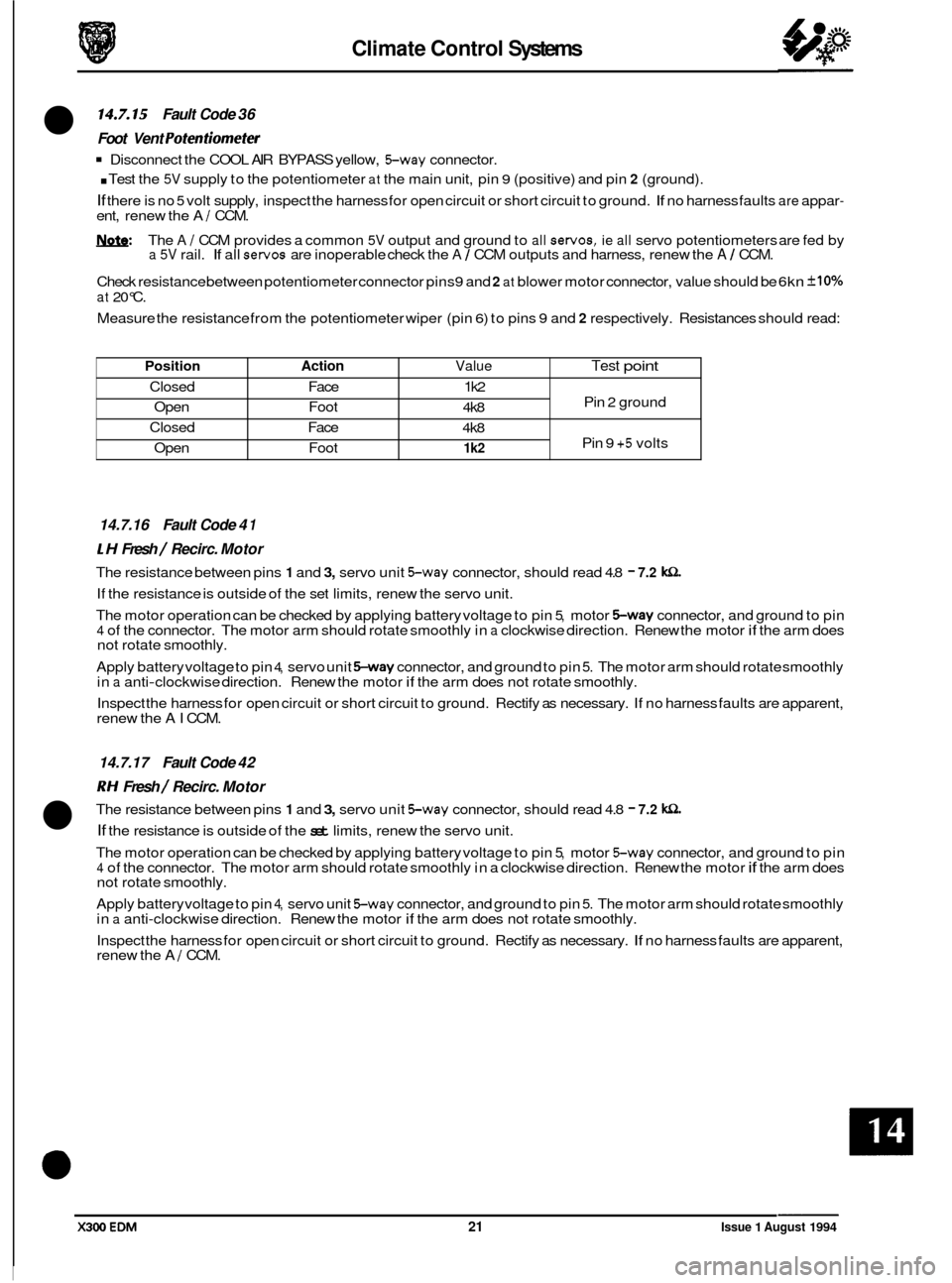
Climate Control Systems
Position Action Value Test point
Closed Face 1 k2
Open Foot
4k8
Closed Face
4k8
Open Foot
1 k2
Pin 2 ground
Pin
9 +5 volts
14.7.15 Fault Code 36
Foot Vent
Potentiometer
Disconnect the COOL AIR BYPASS yellow, Sway connector.
. Test the 5V supply to the potentiometer at the main unit, pin 9 (positive) and pin 2 (ground).
If there is no 5 volt supply, inspect the harness for open circuit or short circuit to ground. If no harness faults are appar- ent, renew the A I CCM.
&&: The A I CCM provides a common 5V output and ground to all servos, ie all servo potentiometers are fed by a 5V rail. If all servos are inoperable check the A 1 CCM outputs and harness, renew the A 1 CCM.
Check resistance between potentiometer connector pins9 and
2 at blower motor connector, value should be 6kn +10%
at 20°C.
Measure the resistance from the potentiometer wiper (pin
6) to pins 9 and 2 respectively. Resistances should read:
14.7.16 Fault Code 4 1
1 H Fresh / Recirc. Motor
The resistance between pins 1 and 3, servo unit Sway connector, should read 4.8 - 7.2 kn.
If the resistance is outside of the set limits, renew the servo unit.
The motor operation can be checked by applying battery voltage to pin
5, motor %way connector, and ground to pin 4 of the connector. The motor arm should rotate smoothly in a clockwise direction. Renew the motor if the arm does
not rotate smoothly.
Apply battery voltage to pin
4, servo unit %ay connector, and ground to pin 5. The motor arm should rotate smoothly
in a anti-clockwise direction. Renew the motor if the arm does not rotate smoothly.
Inspect the harness for open circuit or short circuit to ground. Rectify as necessary.
If no harness faults are apparent,
renew the AI CCM.
14.7.17 Fault Code 42
RH Fresh / Recirc. Motor
The resistance between pins 1 and 3, servo unit Sway connector, should read 4.8 - 7.2 kn.
If the resistance is outside of the set limits, renew the servo unit.
The motor operation can be checked by applying battery voltage to pin
5, motor Sway connector, and ground to pin 4 of the connector. The motor arm should rotate smoothly in a clockwise direction. Renew the motor if the arm does
not rotate smoothly.
Apply battery voltage to pin
4, servo unit Sway connector, and ground to pin 5. The motor arm should rotate smoothly
in a anti-clockwise direction. Renew the motor if the arm does not rotate smoothly.
Inspect the harness for open circuit or short circuit to ground. Rectify as necessary.
If no harness faults are apparent,
renew the A I CCM.
21 Issue 1 August 1994
Page 181 of 327
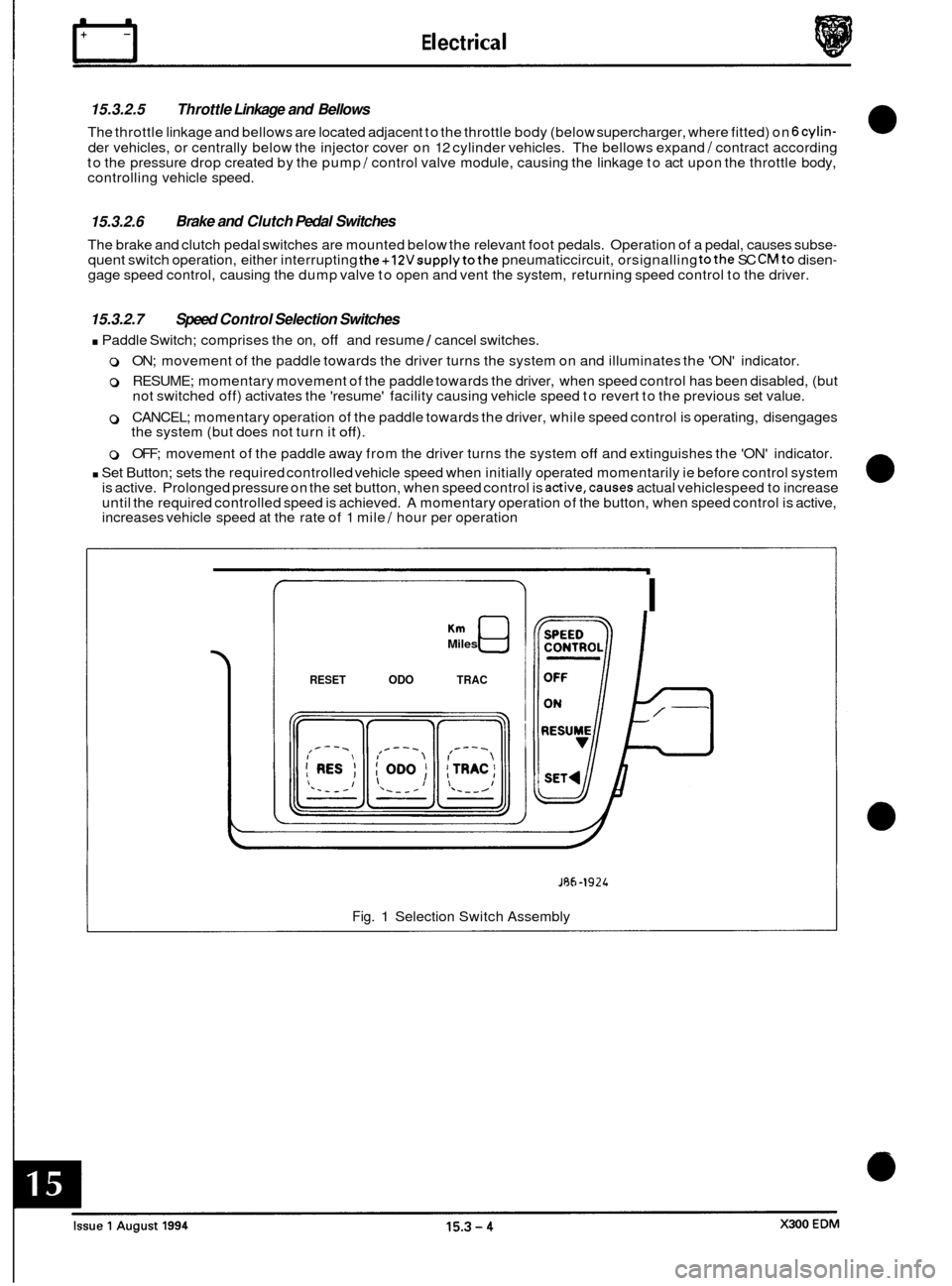
I3 E I ect r ical
15.3.2.5 Throttle Linkage and Bellows
The throttle linkage and bellows are located adjacent to the throttle body (below supercharger, where fitted) on 6cylin-
der vehicles, or centrally below the injector cover on 12 cylinder vehicles. The bellows expand I contract according
to the pressure drop created by the pump I control valve module, causing the linkage to act upon the throttle body,
controlling vehicle speed.
15.3.2.6
The brake and clutch pedal switches are mounted below the relevant foot pedals. Operation of a pedal, causes subse- quent switch operation, either interrupting the+12Vsupplytothe pneumaticcircuit, orsignalling tothe SC CMto disen- gage speed control, causing the dump valve to open and vent the system, returning speed control to the driver.
Brake and Clutch Pedal Switches
15.3.2.7 Speed Control Selection Switches
. Paddle Switch; comprises the on, off and resume 1 cancel switches.
0 ON; movement of the paddle towards the driver turns the system on and illuminates the 'ON' indicator.
0 RESUME; momentary movement of the paddle towards the driver, when speed control has been disabled, (but
not switched off) activates the 'resume' facility causing vehicle speed to revert to the previous set value.
0 CANCEL; momentary operation of the paddle towards the driver, while speed control is operating, disengages
the system (but does not turn it off).
0 OFF; movement of the paddle away from the driver turns the system off and extinguishes the 'ON' indicator.
. Set Button; sets the required controlled vehicle speed when initially operated momentarily ie before control system
is active. Prolonged pressure on the set button, when speed control is active,causes actual vehiclespeed to increase
until the required controlled speed is achieved. A momentary operation of the button, when speed control is active,
increases vehicle speed at the rate of 1 mile
/ hour per operation
Miles
RESET ODO TRAC
I
JRh-1924
Fig. 1 Selection Switch Assembly
Page 187 of 327

rl E I ect r ica I
5. Dump valve
a.
b.
Unplug connector from valve and test continuity across solenoid (pins 1 and 2). A resistance value of
approximately 4052 should be recorded.
Examine harness wiring, checking continuity between valve pins 1 and
2 and SC CM pins 4 and
3 respectively.
6. Control valve / pump unit
a. Unplug connector from unit and test continuity across valve solenoid (pins 3 and 2). A
resistance value of approximately 8552 should be recorded.
b. Test continuity across pump motor (pins 3 and 1, refer to Fig 1). A resistance value of approx.
2052 should be recorded.
c. Examine harness wiring, checking continuity between unit pins 1,2 and 3 and SC
CM
pins 20, 10 and 3 respectively.
I Ii
1
1. Speed Control Control Module (SC CM) 7. Dumpvalve
2. Clutch Switch / Link 8. Control Valve / Pump Unit
3. Brake Switch 9. Gear Position Module
4. LH 'A' Post Base Fuse-box 10. ABS Control Module
5. Switch Pack
11. Instrument Pack 6. Column Switchgear Dimmer
Fig. 1 Dump Valve and Control Valve
/ Pump Unit
0
0
0
0
Issue 1 August 1994 15.3 - 10 X300 EDM
Page 200 of 327
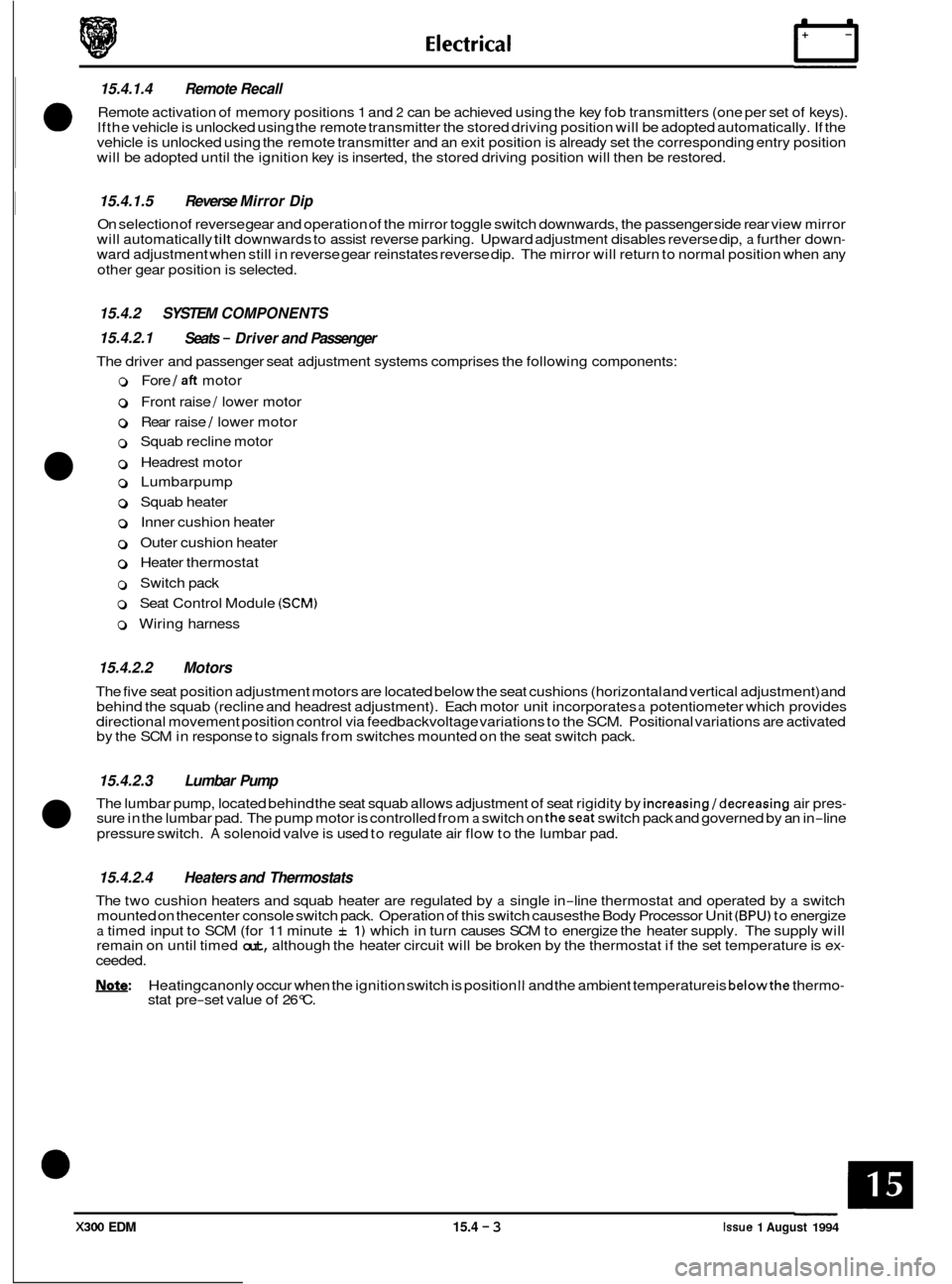
15.4.1.4 Remote Recall
Remote activation of memory positions 1 and 2 can be achieved using the key fob transmitters (one per set of keys).
lfthe vehicle is unlocked using the remote transmitter the stored driving position will be adopted automatically. If the
vehicle is unlocked using the remote transmitter and an exit position is already set the corresponding entry position
will be adopted until the ignition key is inserted, the stored driving position will then be restored. 0 ~
15.4.1.5
Reverse Mirror Dip
On selection of reverse gear and operation of the mirror toggle switch downwards, the passenger side rear view mirror
will automatically tilt downwards to assist reverse parking. Upward adjustment disables reverse dip, a further down- ward adjustment when still in reverse gear reinstates reverse dip. The mirror will return to normal position when any
other gear position is selected.
15.4.2 SYSTEM COMPONENTS
15.4.2.1 Seats
- Driver and Passenger
The driver and passenger seat adjustment systems comprises the following components:
o Fore / aft motor
o Front raise / lower motor
o Rear raise / lower motor
0 Squab recline motor
0 Headrest motor
0 Lumbarpump
0 Squab heater
0 Inner cushion heater
0 Outer cushion heater
0 Heater thermostat
0 Switch pack
o Seat Control Module (SCM)
o Wiring harness
15.4.2.2 Motors
The five seat position adjustment motors are located below the seat cushions (horizontal and vertical adjustment) and
behind the squab (recline and headrest adjustment). Each motor unit incorporates a potentiometer which provides
directional movement position control via feedbackvoltage variations to the SCM. Positional variations are activated
by the SCM in response to signals from switches mounted on the seat switch pack.
15.4.2.3 Lumbar Pump
The lumbar pump, located behind the seat squab allows adjustment of seat rigidity by increasing/decreasing air pres- sure in the lumbar pad. The pump motor is controlled from a switch on theseat switch pack and governed by an in-line
pressure switch.
A solenoid valve is used to regulate air flow to the lumbar pad.
15.4.2.4 Heaters and Thermostats
The two cushion heaters and squab heater are regulated by a single in-line thermostat and operated by a switch
mounted on thecenter console switch pack. Operation of this switch causesthe Body Processor Unit (BPU) to energize a timed input to SCM (for 11 minute f 1) which in turn causes SCM to energize the heater supply. The supply will
remain on until timed out, although the heater circuit will be broken by the thermostat if the set temperature is ex- ceeded.
Note: Heatingcan only occur when the ignition switch is position I1 and the ambient temperature is belowthe thermo- stat pre-set value of 26°C.
X300 EDM 15.4 - 3 Issue 1 August 1994
Page 205 of 327
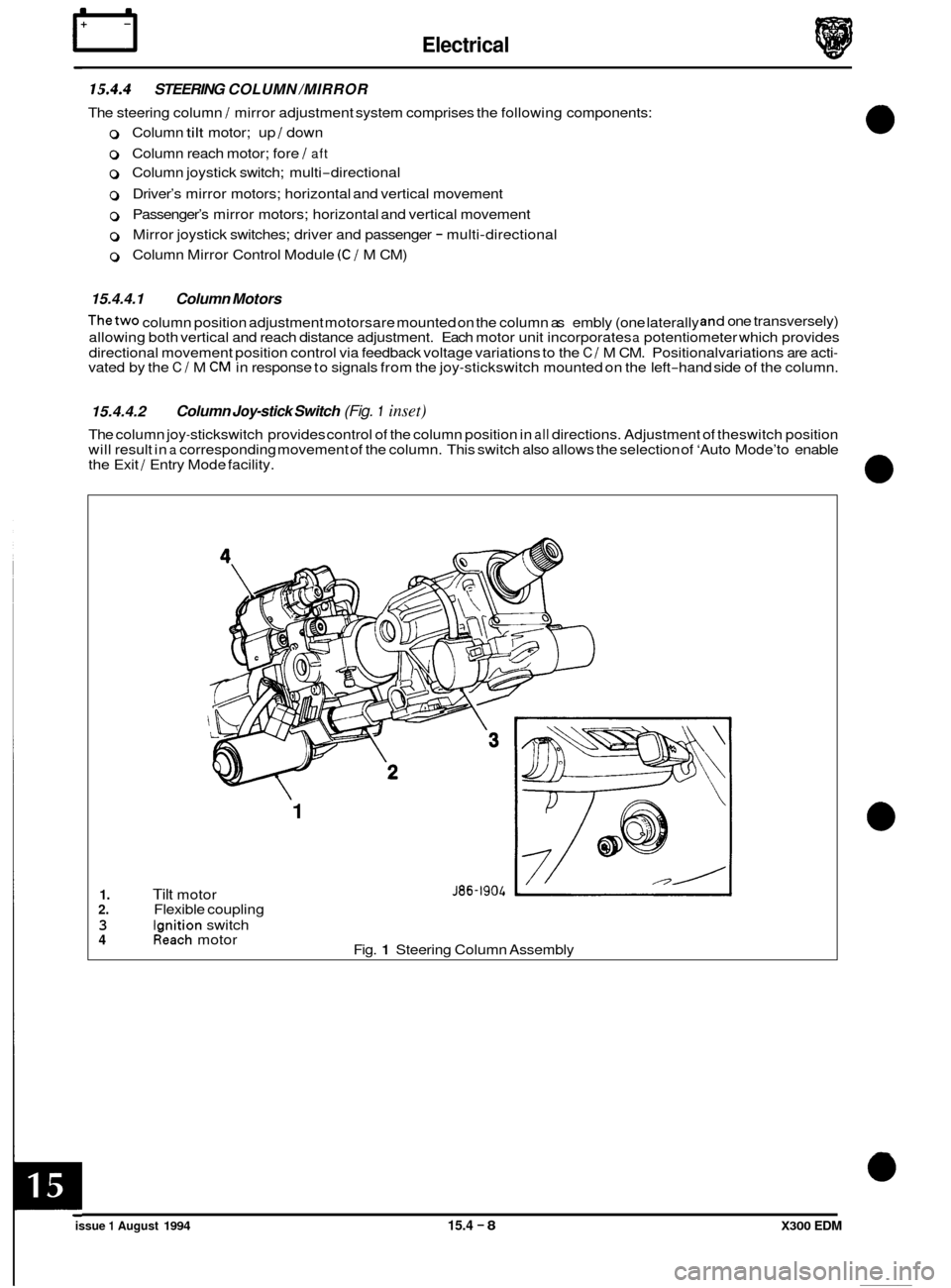
rl Electrical
15.4.4 STEERING COLUMN /MIRROR
The steering column / mirror adjustment system comprises the following components:
0 Column tilt motor; up / down
0 Column reach motor; fore / aft
0 Column joystick switch; multi-directional
0 Driver’s mirror motors; horizontal and vertical movement
0 Passenger’s mirror motors; horizontal and vertical movement
0 Mirror joystick switches; driver and passenger - multi-directional
0 Column Mirror Control Module (C / M CM)
15.4.4.1 Column Motors
Thetwo column position adjustment motorsare mounted on the column as embly (one laterally d
one transversely)
allowing both vertical and reach distance adjustment. Each motor unit incorporates a potentiometer which provides
directional movement position control via feedback voltage variations to the
C / M CM. Positional variations are acti- vated by the C / M CM in response to signals from the joy-stickswitch mounted on the left-hand side of the column.
15.4.4.2
The column joy-stickswitch provides control of the column position in all directions. Adjustment of theswitch position
will result in a corresponding movement of the column. This switch also allows the selection of ‘Auto Mode’to enable
the Exit / Entry Mode facility.
Column Joy-stick Switch (Fig. 1 inset)
1. Tilt motor 2. Flexible coupling
3 lanition switch
1
J86-1904
Ifeach motor
Fig. 1 Steering Column Assembly 4
issue 1 August 1994 15.4 - 8 X300 EDM
Page 210 of 327
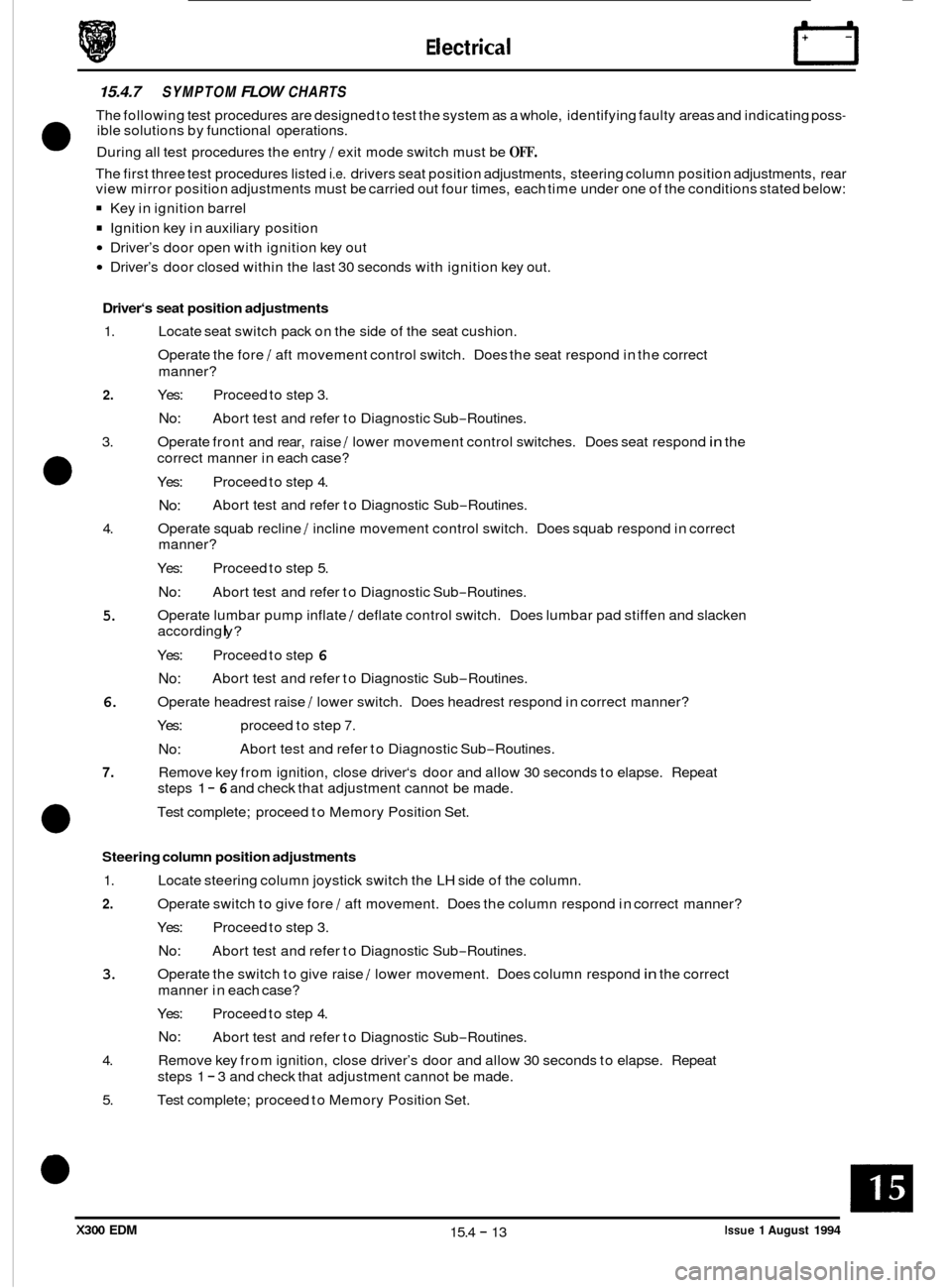
E I ect r ica I
15.4.7 SYMPTOM FLOW CHARTS
The following test procedures are designed to test the system as a whole, identifying faulty areas and indicating poss- ible solutions by functional operations.
During all test procedures the entry
/ exit mode switch must be OFF.
The first three test procedures listed i.e. drivers seat position adjustments, steering column position adjustments, rear
view mirror position adjustments must be carried out four times, each time under one of the conditions stated below:
Key in ignition barrel
Ignition key in auxiliary position
Driver’s door open with ignition key out
Driver’s door closed within the last 30 seconds with ignition key out.
0
Driver‘s seat position adjustments
1.
2.
3.
0
4.
5.
6.
7.
0
Locate seat switch pack on the side of the seat cushion.
Operate the fore
/ aft movement control switch. Does the seat respond in the correct
manner?
Yes: Proceed to step 3.
No:
Operate front and rear, raise / lower movement control switches. Does seat respond in the
correct manner in each case?
Yes: Proceed to step 4.
No:
Operate squab recline / incline movement control switch. Does squab respond in correct
manner?
Yes: Proceed to step 5.
No:
Operate lumbar pump inflate / deflate control switch. Does lumbar pad stiffen and slacken
according
I y?
Yes: Proceed to step 6
No:
Operate headrest raise / lower switch. Does headrest respond in correct manner?
Yes: proceed to step
7.
No:
Remove key from ignition, close driver‘s door and allow 30 seconds to elapse. Repeat
steps
1 - 6 and check that adjustment cannot be made.
Test complete; proceed to Memory Position Set.
Abort
test and refer to Diagnostic Sub
-Routines.
Abort test and refer to Diagnostic Sub
-Routines.
Abort test and refer to Diagnostic Sub
-Routines.
Abort test and refer to Diagnostic Sub
-Routines.
Abort test and refer to Diagnostic Sub
-Routines.
Steering column position adjustments
1.
2.
Locate steering column joystick switch the LH side of the column.
Operate switch to give fore
/ aft movement. Does the column respond in correct manner?
Yes: Proceed to step 3.
No:
Operate the switch to give raise / lower movement. Does column respond in the correct
manner in each case?
Yes: Proceed to step 4.
No:
Remove key from ignition, close driver’s door and allow 30 seconds to elapse. Repeat
steps 1
- 3 and check that adjustment cannot be made.
Test complete; proceed to Memory Position Set.
Abort
test and refer to Diagnostic Sub
-Routines.
3.
Abort test and refer to Diagnostic Sub-Routines.
4.
5.
X300 EDM 15.4 - 13 Issue 1 August 1994
Page 211 of 327

Rear view mirror position adjustments
1. Locate mirror select switch on driver's door switch pack and select driver's side mirror, ie
rotate switch towards the door.
2. Locate rear view mirror joystick switch on driver's door pack.
Operate the switch to give left
/ right and up / down movement. Does the mirror respond
in the correct manner?
3. Yes: Proceed to step 4 or 5.
No:
Japanese market vehicles only
Operate the switch to action 'fold away mode'. Does mirror respond in the correct manner
in each case?
Yes: Proceed to step
5.
No:
All markets
Operate mirror select switch to opposite position and repeat steps
1 to 4 for passenger side
mirror.
With ignition switched to auxiliary, select reverse gear and operate mirror joy
-stick
downwards. Does passenger side mirror dip automatically?
Yes: Proceed to step
7.
No:
Remove key from ignition, close driver's door and allow 30 seconds to elapse. Repeat
steps
1 - 6 and check that adjustment cannot be made.
Test complete; proceed to Memory Position Set.
Abort
test and refer to Diagnostic Sub
-Routines.
4.
Abort test and refer to Diagnostic Sub-Routines.
5.
6.
Abort test and refer to Diagnostic Sub-Routines.
7.
8.
Memory set position - drivefs side
1.
2.
3.
4.
5.
6.
7.
8.
Position the entry / exit switch, located on the LH side of the steering column, to off and
insert the key in the ignition.
Operate switches to position column, mirrors and seats to preferred positions.
Select 'memory' on the driver's door switch pack. Check that switch illuminates.
Depress desired memory button,
1,2 or 3, on door switch pack within 4 seconds of
memory select. Check that a chime sounds to confirm memory storage.
Operate the switches
so that memorized positions are changed. Depress relevant memory
option button,
1,2 or 3 and check that all positional settings are restored as memorized.
Remove key from ignition, close all doors and allow
30 seconds to elapse. Repeat steps 1
to 4 and check that adjustment cannot be made.
Readjust settings so that memorized positions are changed, leave the vehicle and operate
remote memory recall by locking and unlocking using the remote transmitter. Use both
transmitters to check both memory positions. Check all positional settings are restored as
memorized.
Yes: Proceed to step
8.
No:
Test complete. Abort
test and refer to Diagnostic Sub
-Routines.
X300 EDM Issue 1 August 1994 15.4 - 14
Page 212 of 327
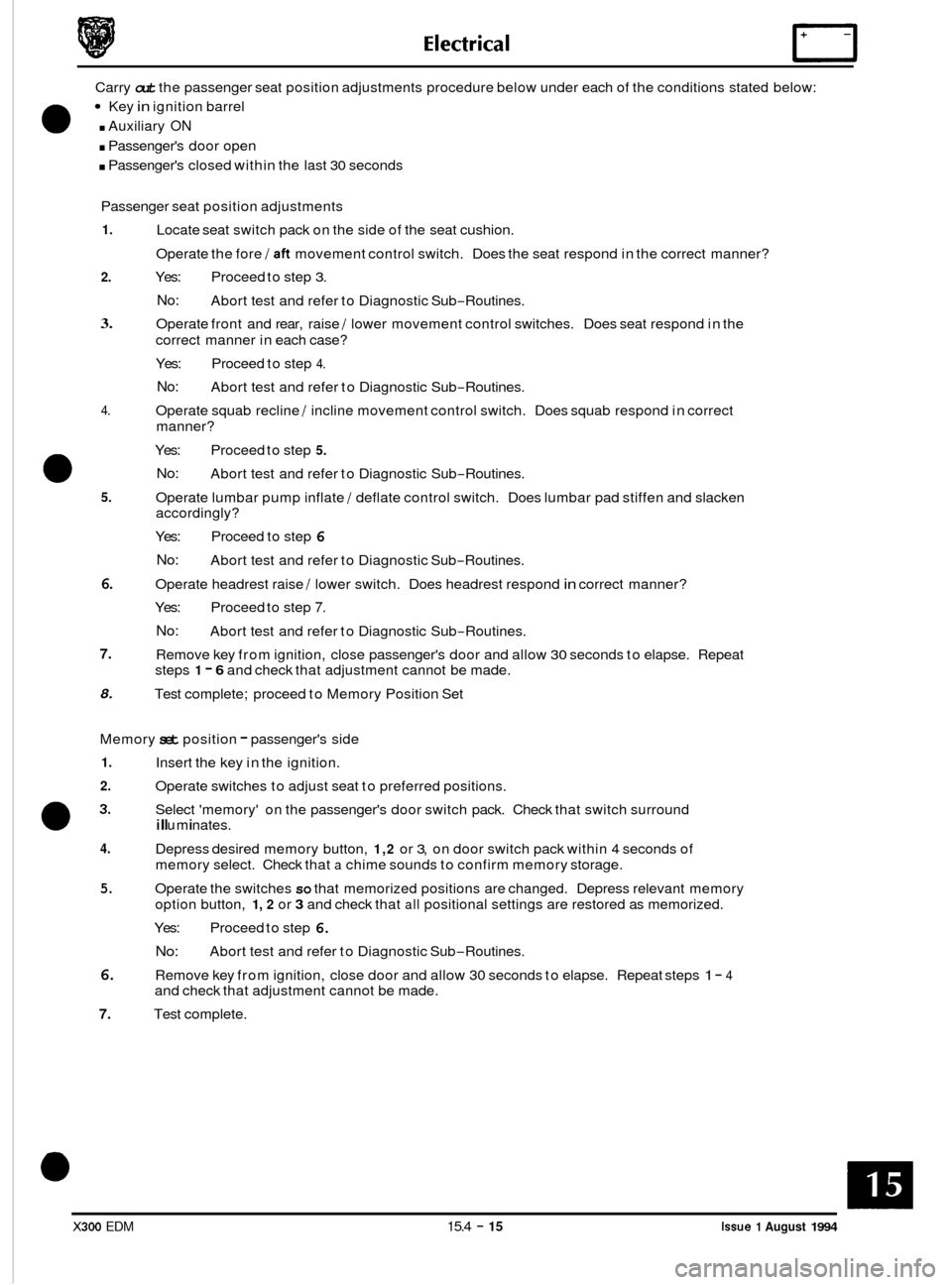
Carry out the passenger seat position adjustments procedure below under each of the conditions stated below:
Key in ignition barrel
. Passenger's door open
. Passenger's closed within the last 30 seconds
0 . Auxiliary ON
Passenger seat position adjustments
1.
2.
3.
4.
5.
0
6.
7.
8.
Locate seat switch pack on the side of the seat cushion.
Operate the fore
/ aft movement control switch. Does the seat respond in the correct manner?
Yes: Proceed to step
3.
No:
Operate front and rear, raise / lower movement control switches. Does seat respond in the
correct manner in each case?
Yes: Proceed to step
4.
No:
Operate squab recline / incline movement control switch. Does squab respond in correct
manner?
Yes: Proceed to step
5.
No:
Operate lumbar pump inflate / deflate control switch. Does lumbar pad stiffen and slacken
accordingly?
Yes: Proceed to step
6
No:
Operate headrest raise / lower switch. Does headrest respond in correct manner?
Yes: Proceed to step
7.
No:
Remove key from ignition, close passenger's door and allow 30 seconds to elapse. Repeat
steps
1 - 6 and check that adjustment cannot be made.
Test complete; proceed to Memory Position Set
Abort
test and refer to Diagnostic Sub
-Routines.
Abort test and refer to Diagnostic Sub
-Routines.
Abort test and refer to Diagnostic Sub
-Routines.
Abort test and refer to Diagnostic Sub
-Routines.
Abort test and refer to Diagnostic Sub
-Routines.
Memory
set position - passenger's side
1.
2.
0 3.
4.
5.
6.
7.
0
Insert the key in the ignition.
Operate switches to adjust seat to preferred positions.
Select 'memory' on the passenger's door switch pack. Check that switch surround
i I I um i nates.
Depress desired memory button,
1,2 or 3, on door switch pack within 4 seconds of
memory select. Check that
a chime sounds to confirm memory storage.
Operate the switches
so that memorized positions are changed. Depress relevant memory
option button,
1, 2 or 3 and check that all positional settings are restored as memorized.
Yes: Proceed to step
6.
No:
Remove key from ignition, close door and allow 30 seconds to elapse. Repeat steps 1 - 4
and check that adjustment cannot be made.
Test complete. Abort
test and refer to Diagnostic Sub
-Routines.
X300 EDM 15.4 - 15 Issue 1 August 1994